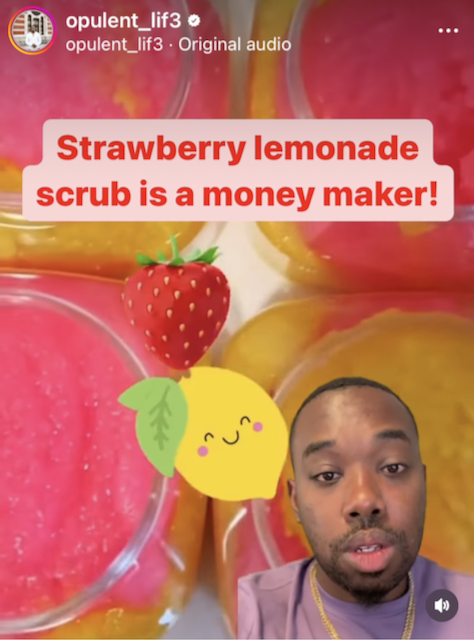I’ve been seeing posts from David Wongk for a course and Facebook group called “Start a 6 Figure Beauty Business” where you learn to make massive batches of really easy products using a variety of bases to create yourself a business where you can make a six figure (gross) income. There are free “recipes” available on his Instagram account and Facebook group, but there’s also a course they’re selling for $4,997, which is discounted to something like $997 right now. These are all illustrated with short videos that don’t appear to be showing the products he’s telling you to make and appear to be composed of someone else’s work?
Yep, all you have to do is make 30 pounds of lip gloss or 33+ pounds of sugar scrub and in no time, you’ll be making 6 figures!!! Become a beauty mogul today!!!
Short disclaimer: I’m absolutely fascinated by this program the way I’m fascinated by Fyre Festival, Caroline Calloway, Anna Delvey, Theranos, We Work, and MLMs. I keep going back to read more! If you’d like to see me analyze more recipes, please share your thoughts in the comments.
- First things first…this promise is nigh unattainable!
- What kinds of recipes are they sharing?
- A thought on copyright of these recipes…
- Why did I call it them "recipes", not a formulas?
- A thought on using bases…
- First things first, do not make the "lotion"!
- If you want to make a quick and easy lotion…
- One ingredient oil for $125?
- The math on marula oil!
- How can you make this product?
- Want to make a 100% squalane formula?
- Want to make a 100% rosehip oil formula?
- Let's analyze the "lip gloss recipe" for composition and profit!
- But wait a second, don't you also have to sell 1,438 lip glosses to make money?
- How do you differentiate your products from the others? How do you get customers to come back?
- What can you do if you want to make some nice lip gloss?
- A thought on these massive quantities of product…
- Let's look at the muscle gel recipe!
- What can we do if we want to make a muscle rub gel?
- A note on eucalyptus essential oil in Canada!
- How do we figure out cost of our products?
- You can't make drug claims about cosmetics!
- Do not use any of these recipes to make intimate care products at home!
- An aside on creating your own business…
- Where to find easy-to-make formulas on this site?
First things first…this promise is nigh unattainable!
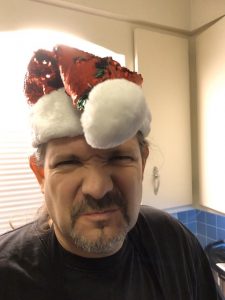
Save your time, save your money, save your energy. In my opinion, the chances of you creating a sustainable “6 Figure Beauty Business” as measured in Canadian or American dollars with these recipes are very very low.*
*I’m not saying it’s impossible because we see seemingly impossible things every day and I’m sure there’s someone out there who will prove me wrong, but much like with the stats for MLMs, only a tiny fraction will have the opportunity to come close to those kind of numbers.
In my opinion, these recipes aren’t creating sophisticated, well formulated, stable products. As you’ll see, there’s no formulating involved, just buying bases from larger companies and mixing them with other things to make final products. I’m not saying products using those ingredients are inherently not good, but my formulating skills tell me the ones I saw and I’ll be sharing with you have little potential or you’re making them in such quantity that making money will be a struggle.
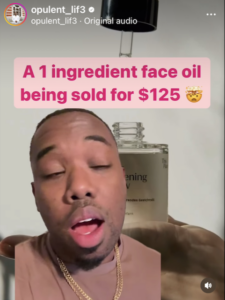
The reality is you aren’t likely to get $50 for a four ingredient sugar scrub or $125 for 30 ml of marula oil. Known brands have label cachet and can demand high prices. New or unknown small businesses can’t come into a market and expect to charge the same.
One of the things that saddens me the most are the questions I’ve seen from those using the free recipes asking where to sell their products, and you know it’ll cost you the price of the course to learn that information beyond a generic “online” or “in a shop”. I don’t see anyone offering information other than “contact your local hair salon” or “look up craft fairs”, which is generic and unhelpful.
Almost anyone can combine 8 pounds of foaming bath whip and 25 pounds of white sugar with 16 ounces Castile soap along with fragrance oils and micas to make a 33+ pounds (14.97 kg) strawberry lemonade sugar scrub. How you sell that is a completely different story, and something these free groups and paid course are very unlikely to help you do, especially for the prices they suggest you charge.
You’re probably much better off getting your business plan from some underpants gnomes.
What kinds of recipes are they sharing?
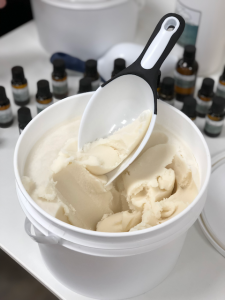
These are almost all bases with additional ingredients. The instructions consist of things like buy a base, add some fragrance or essential oil, maybe add a colourant, make a label that doesn’t contain INCI names and makes all kinds of outrageous claims, then package the product to sell it.
You aren’t making a lotion from scratch – you’re buying a base from Amazon.
You’re using pre-made ingredients, like aloe vera gel or foaming bath whip.
You’re buying melt & pour soap and adding shea butter to it to make a shampoo bar. (Oh yeah, I’m mad about that one. It’s so bad for your hair!)
Pouring marula oil into a bottle and slapping a label on it isn’t a “recipe”, it’s decanting. It’s fine if you want to do that – as you’ll see there are loads of companies selling 100% pure (something) in a fancy bottle – but it’s not an original idea. There isn’t even a process given, like “use a pipette” or “buy a syringe”.
This isn’t formulating: There are no measurements, just opening packages and dumping them into buckets, then mixing.
There’s an old Instructables for a chicken Caesar salad wrap that went something like this: Step one, get a chicken Caesar salad; step two, get a wrap… These are about as complicated. Okay, now I want a chicken Caesar salad wrap…
A thought on copyright of these recipes…
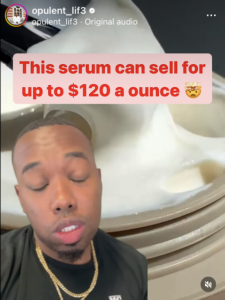
I’m sharing recipes I’ve found on their public Instagram page as they have been offered as an educational tool to teach analysis of formulas and products and to share what little I know about business. I know someone out there will really want to call me on “copyright infringement”, but I don’t consider anything I’ve shared here to be a unique creation, except perhaps the massage gel. (Nope, changed my mind on that the more I analyzed it.)
I’ve seen suggestions for these kinds of modifications of bases from blogs, forums, suppliers’ shops, arts & crafts stores, Facebook groups, Instagram accounts, and so many other places over the last 17 years – they’re pretty common. I’ve shared some myself on this site. Having said that, I’m open to hearing any arguments if you think I’m wrong and you think I should be offering more credit. I wouldn’t normally share the name of the recipes or the social media accounts as my goal isn’t to make someone feel bad, I’m just sharing some information about something that worries me, but in this case, this program has me deeply concerned and I thought I should offer some ideas on how to make these things in case someone really wants to try it.
Having said that, I consider this fair use as I’m analyzing something that’s been shared in a public forum. I’ve also made this post free to read so there’s no accusations of using someone else’s work for my financial gain. (If only other people would give me that consideration, eh?)
The screenshots I’ve used are for illustrative purposes only and I’m sharing those for that purpose. The copyright remains with the person who owns it, not me. If someone has an issue with this, please let me know and I will be happy to modify this section to include the copyright information for those stills from videos.
Why did I call it them “recipes”, not a formulas?
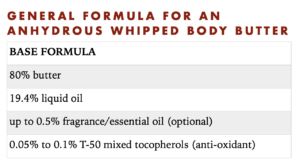
Because these aren’t formulas. Formulas come in percentages and we make them by weight. As you’ll see, there aren’t even recipes offered you can follow. The process is to buy the right amount from the shop, open the container, pour it into a bucket, mix, you’re done. Honestly, I hesitate to call them recipes as there’s no art to this – it’s just buy the things, pour them out, package, label, sell.
This to your is a formula. Note it’s in percentages that we’ll convert to the word “grams” to make a weighted formula. Formulas don’t have to be complicated, but they do need to total 100%.
Related post: Beginners! Let’s talk about formulas
A thought on using bases…
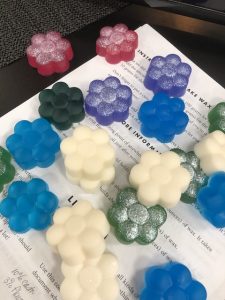
There are loads of situations when you’d use a base or a pre-made product to make an awesome product. Using a base doesn’t make something not great or not well formulated.
If you wanted a quick and easy aloe vera gel with a bit of essential oil in it, buy some and add the essential oil by weight to the product. It’s a great choice if you don’t want to buy all those ingredients and worry about preservation and such.
Foaming bath whip or bath butter is a wonderful way to make a quick and easy body wash or sugar scrub by adding a bit of carrier oil with a fragrance/essential oil.
Related posts:
Foaming bath butter scrubs with jojoba beads
Creating a pumpkin seed & orange oil degreasing foaming bath butter scrub
Melt & pour soap is great fun for those of us who don’t want to make cold process soap or worry about using lye because you’re clumsy as heck.
Related posts: Sushi soap – maki roll!
You can make awesome products with these bases – I share a few ideas in this post and we’ll be making our own bases over the next two months on this site – and you can call them formulas. I’m referring specifically to the way these are made and measured on that specific site.
First things first, do not make the “lotion”!
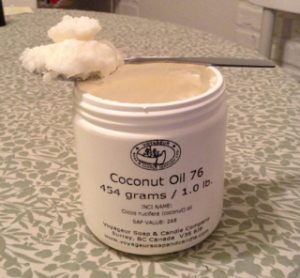
This is the worst thing ever and we’ve discussed it before on this site (but I can’t find it now). It’s a variation on an old thing that’s been going around DIY sites since well before I started formulating in 2006. You can see a variation on it on this site.
It’s something like 1/4 cup coconut oil, 1/4 cup aloe vera gel, and 1/4 cup shea butter with a few drops of this or that for fragrance. Mix, pour into a bottle, call it a lotion, and profit!
This will fail miserably because you can’t combine a water soluble thing – the aloe vera gel – with oils and expect them to stay together without an emulsifier. You’re combining it with a spatula – why do people love freakin’ spatulas so much? Do they bring in that much money in affiliate links? – so it’s not like you have some high powered mixing happening.
There’s no way to make this work properly. To do so, requires us to completely rewrite this to include a water phase, oil phase, cool down phase, preservative, water, and more. Just find a nice formula and make that in small quantities.
Related post: Tips & techniques: Why it’s ill advised to use Aloe Vera Gel in emulsions!
If you want to make a quick and easy lotion…
If you want to make a lotion, may I suggest starting with this one – basic lotion formula from my beginners’ section of the site – as it’s basically foolproof if you follow the formula and directions as written. There are loads of formulas for six ingredient lotions and whole series on making beginner formulas with different emulsifiers in that section, so I’ll refer you over there to see all that’s on offer.
One ingredient oil for $125?
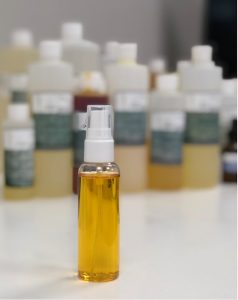
In one “recipe” this course suggests you’ll sell bottles of 100% marula oil for $125 for 30 ml (1 ounce/2 tablespoons). You will not.
Even GOOP isn’t trying this kind of price, and she charges a fortune for things like sunflower oil.
Drunk Elephant Virgin Marula Luxury Face Oil is $92 for 30 ml at Sephora. They can only charge this because they’re Drunk Elephant.
The Face Shop charges $60 Canadian for an unknown amount.
The Ordinary sells this for $12.80 Canadian, which would still make you some serious money considering how simple this is to make.
How does this work? You buy a gallon (3.75 litres), dispense 30 millilitres (1 fluid ounce) into a bottle, label it, and you’re done. You have a 6 Figure Beauty Business!
This would work out to $140 x 3.75 litres = $525 Canadian from Windy Point Soap Making Supplies. Its specific density is 0.915 to 0.925 grams per millilitre, so 3.75 litres would equal 3,450 grams marula oil, which works out to ¢15.65 per gram.
Each 30 ml (1 ounce, 2 tbsp) bottle would contain 27.6 grams marula oil in each bottle, which works out to $4.20 Canadian for a bottle, not including the bottle and label. If you charge $125 per bottle, you’ve made $120.80 per bottle before the cost of bottle, label, funnel, clean up, your time, transport, etc. Wow, that’s pretty darned amazing!
And you can get 125 bottles of $125 marula oil from a $525 gallon/3.75 litre container of marula oil, which works out to $15,625! You’re making a profit of $15,100! That’s almost 2900% or 29 times profit! Why are you sitting here when there’s that much money to be made???
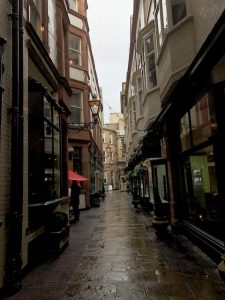
Because this is idiocy. You don’t just make a product, slap a huge price on it, and expect to sell each and every drop of it and make tons of money. If it were that easy, I’d be doing that as a side gig and writing this from Water Street in Liverpool, eating Scotch eggs in my little pied-de-terre in England with Sasja sighing softly beside me while a large workshop is under construction in an adjoining flat.
You know that’s not how business works. If you’ve ever thought about starting a business, you know it’s not all hearts and flowers and roses and $15,000 paydays with your first product.
One, if the business is that good, someone else is going to get in on it. I remember once reading that 10% profit was good, 20% was amazing, and if you were making that much, someone else would horn in on your racket and undercut you when they realized it.
Two, you aren’t Drunk Elephant or GOOP. You aren’t The Ordinary. You’re a new business with a new name and no one knows who you are. You can create a killer website and have killer social media, but that won’t necessary translate into sales or even anyone knowing you’re there. Sadly, so much of making personal care and cosmetic products is about marketing, about names and perception. Bobbé’s Chateau de les Produits Géant 100% Marula Oil isn’t going to command $125 a bottle, even if it’s organic.
The math on marula oil!
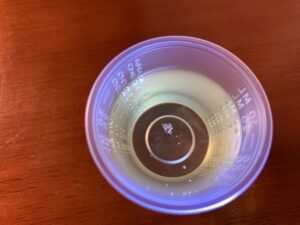
1 gallon marula oil = 3.75 litres marula oil
0.92 grams marula oil = 30 millilitres (1 fluid ounce, 2 tbsp).
3.75 litres marula oil = 3,750 millilitres x 0.92 grams/ml = 3,450 grams in 1 gallon/3.75 litres marula oil
$525 for 3,450 grams marula oil = ¢15.22 per gram
1 bottle = 30 ml. 0.92 grams/ml x 30 ml = 27.6 grams
27.6 grams x ¢15.22 per gram = $4.20072 or $4.20 per bottle.
3,450 grams ÷ 27.6 grams per bottle = 125 bottles from 1 gallon/3.75 litres marula oil
125 bottles x $125 per bottle = $15,625
$15,625 – $525 = $15,100.
I didn’t bother looking up the cost of a fancy glass bottle because there’s a huge range of costs for those, but they aren’t going to be $100 each. The “profit” will be very similar.
How can you make this product?

Get a bottle of marula oil, much less than 1 gallon. Start with 120 ml (4 ounces) or 250 ml (around 8 ounces).
Get a pipette, preferably one that’s at least 7 ml, but larger isn’t a bad idea. Squish 30 ml (1 ounce) into a 30 ml bottle or measure it by weight to make up 30 ml.
Clean the bottle with a spray of rubbing or isopropyl alcohol to remove the grease.
Put on a pretty label, sell, rejoice. That was easy, eh?
Want to make a 100% squalane formula?
Buy some squalane. Get a pipette, preferably one that’s at least 7 ml, but larger isn’t a bad idea. Squish 30 ml (1 ounce) into a 30 ml bottle…
See the video tutorial and accompanying post here – Duplication (video): The Ordinary or Peter Roth’s 100% squalane or Josie Maran’s 100% Argan oil – if you want more detail.
Want to make a 100% rosehip oil formula?
Buy a bottle of rosehip oil. Get a pipette…you get the idea.
Let’s analyze the “lip gloss recipe” for composition and profit!
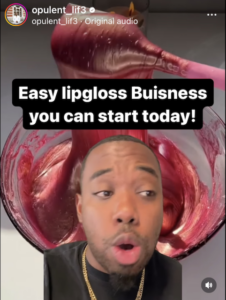
30 pounds (13.6 kg) of base from TKB Trading known as Flexagel M for $421 US. This one has a specific gravity of 0.95 grams to 1.05 grams per millilitre according to the SDS, so let’s say 1 gram = 1 ml.
8 ounces cherry kernel oil for $18.99 from Cocojojo. This has a specific gravity of 0.91 to 0.925 grams per millilitre. We have 236.59 millilitres in 8 fluid ounces, so we have 217.7 grams cherry kernel oil (averaging 0.92 grams per millilitre).
Rascally Rose – 4 ounces (113 grams) TKB for $79
TKB Fantasia – 4 ounces (113 grams) TKB for $69
TKB Unicorn – 4 ounces (114 grams) from TKB for $69
Strawberry sorbet lip balm from Nature’s Garden for $12.59 for 4 ounces
Mango lip balm flavour from Nature’s Garden for $11.33 for 4 ounces
I have no idea the weight of the flavours, but let’s say they’re 113 grams as well, so we have 782.7 grams of these things + 13.6 kilograms = 14.3827 kilograms or 14.3 kilograms (31.53 pounds) of product, rounded down as we’ll lose a lot filling up these little containers.
These lip balm containers from Amazon contain 10 ml each and are $29.99 for 100.
If we can put 10 grams of product into each one – it’ll actually be less, probably 8 grams per container but there’s a lot of loss and mess when filling lip gloss tubes, but let’s say 10 grams to account for all of that – – we can make 1,438 lip balms! Holy cow!
So we’ve spent $680.91 US for the ingredients and $449.85 for 1,500 lip balm tubes for a grand total of $1,130.76 US. It works out to ¢78.6 or ¢79 for each one so far before you start adding your time for ordering, making, packaging, and labelling; labels; supplies like funnels or syringes; your website or Etsy store; costs like taxes, duties, customs, and shipping that you’re paying for when ordering and when selling; and a lot more.
A new version came out today, September 8, 2023, using 3 pounds of lip gloss base and grape seed oil. This will around 136 lip glosses with a 3 to 6 month shelf life. Eek!
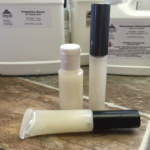
How to make the lip gloss? That takes no skill at all. You put all of this together – no measuring, just pour it all into a “bucket” and stir. Get a syringe or 80 and carefully dispense the lip balm into the containers, which will take you forever and cause quite a mess. Clean off the of the containers, add your labels, and you’re done.
If you sell them for $10 each – which I think might be underselling it, but who knows as you’re an unknown quantity at the moment and we don’t know what the market will bear – you’ll bring in $14,380 for a profit of $13,249.24 for a day’s work in your workshop! You’ll have some losses because lip glosses are a pain to fill and you’ll lose quite a bit.
1,438 lip glosses x $10 each = $14,380 gross
$14,380 gross – $1,130.76 = $13,249.24 net
$10 per lip gloss – 0.79 (costs) = $9.21 profit per lip gloss – works out to $13,243.98, so only a few dollars less than the previous calculation because we rounded up.
$1,130.76 costs – to break even we need to sell around 114 lip glosses to make our money back for the supplies. More when you consider all the other costs that we have for a business. That’s easier, right?
Wow! Just do this 8 more days and you have a 6 Figure Beauty Business! And think about it, I’ve likely underestimated how much you can charge for each lip gloss. Wow!
You can be a millionaire, my friend, just by working a little under 70 days a year if you made this every day! What are you waiting for??? Don’t you want to be rich???
But wait a second, don’t you also have to sell 1,438 lip glosses to make money?
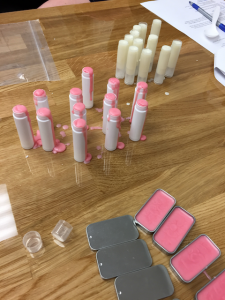
Oh right, the selling part! It’s an important plan of our three step plan:
Step one: Make lip gloss.
Step two: ???
Step three: Profit. (Credit: Underpants gnomes)
How do we do that? Will you have to sell each one to a different person or will people come back for that same colour over and over? Could we get a wholesale account that’ll buy dozens at a time? Can we get an account somewhere online and sell that way? Should we have in-home parties? Is there the potential to create a multi-level marketing system? (No, a million times no!)
That is the $64,000 question: Where do you find your customers?
You could sell wholesale to retailers, like your local salon or gift shop, or you could sell retail in your own place, farmers’ market stand, Christmas craft fair, consignment shop, or other brick-and-mortar store. You could sell online on Etsy or create your own website or through something like Amazon Marketplace. You could even have friends over and demonstrate the awesome power of your lip gloss at a house party.
Sounds pretty easy, but for each of these things, you need to network and market and advertise yourself to try stand out from all the other products people could buy from hundreds and thousands of other product makers.
How to do any of that? I have no idea. This course is promising to show you, but who are they to charge for their services? What expertise do they offer?
Social media helps, probably?
I have a post on that I’ll share in the near future with just some thoughts I had while writing this. I have no expertise in this at all, none whatsoever. I have a few accounts on which I post on various social media and I have thoughts about that. But that’s it. It’s all pretty much a baffling mystery to me.
How do you differentiate your products from the others? How do you get customers to come back?
How do you stand out when there are four other people in town or online trying to sell their 30 pounds of the same colour lip gloss? How do you stand out online when everyone can make a pretty strawberry lemonade sugar scrub that has that same gooey consistency everyone likes? How do you get people’s attention and make a sale?
You have a customer! Yay! They bought something! How to you get them to come back for more? Oh boy, I have no idea at this point. People get advanced degrees in this kind of thing and even they can’t tell you why Furbies became a hit one year and Crystal Pepsi didn’t.
What can you do if you want to make some nice lip gloss?
Get small quantities of lip gloss base, like 150 grams (5.3 ounces) from Voyageur Soap & Candle for $8.40 Canadian, and mix it with some lovely micas, appropriate iron oxides or other more matte colourants, or these EZ Color liquid colours (from Windy Point Soap Making Supplies).
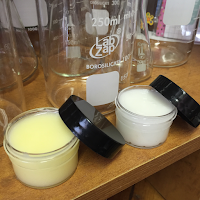
Buy a small bottle or two of sweetened flavours, like these from Windy Point Soap Making Supplies, to give it some flavour. I find this adds to the experience for me. I find 1% to 1.5% is more than enough.
I used cupcake for one of these lip scrubs, pear for the other, and they were both awesome!
Make a small quantity – let’s say 10 grams, and measure everything on a small scale so you can scale it up when you’re ready. You don’t want to use all 150 grams as you might not like the colour, so start small. Add 0.15 cc mica, mix, try it. Add a bit more if you want, and keep doing this until you get what you want. You can mix a blend of micas to make something unique and fun and yours, then use small amounts of that in the formula as well. Keep very good notes as you will want to make this again.
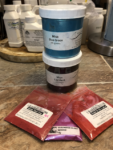
If you want the colour shifting lip glosses, you can use colour shifting micas. There are loads of companies that sell them, so just find one you like near you that is likely to have it the next time you want to order. Amazon is usually not reliable enough for these kinds of things, so choose cosmetic suppliers.
As a note, you don’t need to order from the States and pay a fortune in shipping, duties, taxes, and customs if you’re in Canada for some “big name” mica company as any reputable company carrying micas will have great quality products.
In theory, you can make at least 15 lip glosses (but most probably more) with this base and the micas. If you charge $10 for each one, you’ve made $150 total. Subtract your costs, and you can see you can make some money making this much smaller batch. Plus, you can make loads of batches of all different colours.

The key with making colour cosmetics is getting the base right, then the colour blend right. Then you need to make that blend right every time if you’re making additional batches.
As a note, these lip glosses using Versagel as the base will have a shelf life of about two years because we’re not using natural oils that’ll break down quickly. You could add an anti-oxidant of 0.2% T-50 mixed tocopherols to help the flavour oils retain their awesomeness.
Related e-book: Mineral make-up & colour cosmetics
Related section: I have a number of posts on mineral make-up. I did a search for you here. (The category is MMU, but it’s hard to find that in a search, so look for “mineral makeup” if you want to search more.)
A thought on these massive quantities of product…
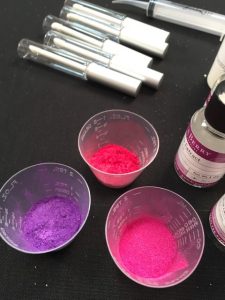
Why make 30 pounds of lip gloss when you can make 1 pound (454 grams), which is still 45 lip balms and at least $450 in sales?
Why make 33+ pounds (14.97 kg) strawberry lemonade sugar scrub – almost 125 – 120 ml (4 ounce) containers – and be stuck with all that product instead of making 10 and seeing what happens?
These sizes are absolutely ridiculous and I guess you have to make that much to make the “profit” seem so amazing. But you aren’t very likely sell most of these quickly if you’re a new business, and everything has a shelf life.
Let’s look at the muscle gel recipe!
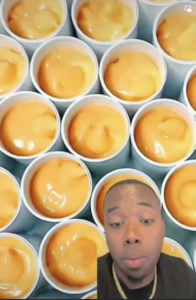
They’re sharing a muscle pain gel using a muscle gel base to which you add a few different oils and essential oils as well as CBD. Pour this all into a bucket, mix, then package. They’re claiming this will treat arthritis, carpal tunnel, and more.
We know that’s absolutely wrong and illegal, claiming drug properties for a cosmetic.
As a note, in the Facebook group, “anonymous member” notes, “Topical products, like lotions and balms, are applied to the skin over a painful joint. Whether these products deliver CBD below the skin is unknown.” So at least there they’re saying this might not help anything.
As a weird note, all the videos posted in that group are by “anonymous member”. Why doesn’t said person just under a name?
Check your local regulations to see if you can even sell a product like this. You can’t make anything in Canada with CBD without some kind of special licence, so you might not be able to sell this product at all. Here’s an article from 2019 for the US. And some things from the FDA on it.
This is what you need to buy for this product…
Muscle gel – $497 US for 5 gallons from Essential Labs (18.93 litres). This contains Menthol, Capsicum, Camphor Oil, Organic Aloe, Muscle Essential Oil Blend, and Meadowfoam Seed Oil. I couldn’t find the specific gravity, so let’s just say that 1 ml = 1 gram, so we have 18.93 kg (41.73 pounds) in the bucket.
Calendula infused oil – $56.25 Can at Voyageur Soap & Candle for 33.8 ounces (1 litre). The specific gravity is 0.92 grams per millilitre, so there’s 920 grams in the bottle.
Camphor essential oil – $29.20 Can at Voyageur Soap & Candle for 16.9 ounces (500 ml). This is 0.8833 grams per millilitre, so there’s 441.65 grams in the bottle.
Arnica infused oil – $24.35 Can at Voyageur Soap & Candle for 8.4 ounces (250 ml). This is 0.919 grams per millilitre, so there’s 229.75 grams per bottle.
50 grams CBD isolate (oil dissolvable). I couldn’t find 50 grams, but I found 100 grams for $149 US for 100 grams (holy cow). I can’t find the specific gravity, so let’s just say it’s 50 ml (1.69 fluid ounces) to make things easier.
By weight you’re making 20,571 grams or 20.57 kilograms or 45.35 pounds. (The math: 18,930 grams + 920 grams + 441.65 grams + 229.75 grams + 50 grams = 20,571.4 grams)
By volume you’re making: 20,730 ml or 20.730 litres or 5.48 gallons of product (The math: 18,930 ml + 1000 ml + 500 ml +250 ml + 50 ml)

If we make these to be 8 ounces or 236.539 ml, we would make 87.638 or 87 bottles (rounded down). So we’d want to buy 8 dozen or 96 bottles like these 8 oz White PET Bullet Bottle with 24-410 Black Pump from Voyageur Soap & Candle for $121.80, which works out to $1.30 Canadian when you buy 8 dozen or 96 bottles. (This is the best price they offer, which would be cheaper than buying 87 bottles individually at $1.61 each, which would be $140.07.)
The total cost for the ingredients and bottles so far – not including the other things you need like labels, packing materials, shipping, your time, disposable things like funnels, and time for your creating and cleaning up – is $880.60 (and we’ll assume this is all the same currency for now.)
You’re spending a grand total of $880.60 before shipping, taxes, duties, and discounts to make 87 – 8 ounce (236.5 ml) bottles. Each bottle works out to $10.12 so far, so you’ll have to sell this for at least $40.48 if you’re using the “four times your cost” calculations for retail.
I think you could try selling 4 ounce bottles. The cost won’t change much because the ingredients will cost the same and the bottles are close enough in price, but you could sell it for slightly more per millilitre or ounce than you could with 8 ounces?
Not as much profit as the lip gloss and $125 marula oil, but you might make some cash from this. Just have to find the right market where someone will pay that kind of money for a cosmetic product that has no certifications.
What can we do if we want to make a muscle rub gel?
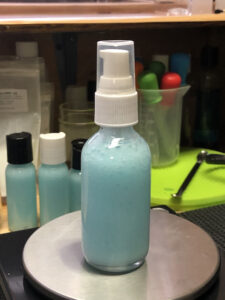
One, don’t make something and claim it can help sore muscles as that’s a drug claim, not a cosmetic claim.
Two, make up a gel, add some essential oils – I like a blend of peppermint or menthol crystals, eucalyptus*, and camphor – by weight, mix well, package. You’re done!
Yes, I know this sounds like making a chicken Caesar salad wrap – get the salad, get a wrap – but it’s really is that easy.
First, make a gel. I’ll suggest using these formulas for a basic Sepimax ZEN or Sepinov EMT 10 gel – or a combination of each at 1.5%. Add your essential oil blend, then mix as directed with a mechanical mixer. You need to do this to make sure it’s hydrated properly and the oil will stay in suspension. If you want to add some oil, you could do 5% of pretty much any liquid emollient to make something awesome. Add put to 1% or 2% essential oil blend.
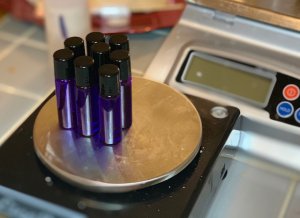
Be careful with essential oils and check their usage before you add them to the gel.
This is a formula I use with a few different combinations of essential oils for my sinuses that works quite nicely in a roller ball on your skin: Super simple festive formulas: Minty snoot blasters, essential oil roller balls, and anhydrous products you can make with essential oils!
Here’s another one – Formula: Essential oil blend that might be like Saje’s Peppermint Halo Headache Remedy
You can find formulas for making an anhydrous Vaseline type balm, cera bellina balm, or a lotion bar in this post – Making Vick’s vapour rub like products with some essential oil combinations...
A note on eucalyptus essential oil in Canada!
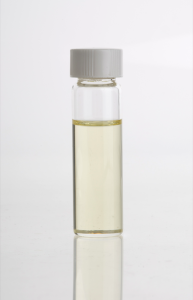
As a note, there have been changes to how much eucalyptus EO you can use products in Canada now. Please note this…
Eucalyptus (Eucalyptus globulus leaf oil; Eucalyptus citriodora oil; Eucalyptus radiata leaf/stem oil; Eucalyptus staigeriana branch/leaf oil; Eucalyptus dives leaf/twig oil) – warnings and cautionary statements are now required for cosmetics that are not in solid form and contain greater than 0.022% eucalyptus: “Keep out of reach of children”; and “In case of accidental ingestion, call a Poison Control Centre or doctor immediately and advise them this product contains eucalyptus oil.”
How do we figure out cost of our products?
This is a great question! There’s a post coming up from a guest writer about how to do this, but for this post, let’s just say that we want to charge at least double our cost of everything – that includes labels, your time, disposable things like funnels or paper towels – as wholesale and four times everything as retail.
This means the minimum you can charge for that muscle gel, for instance, is $20.24 wholesale and $40.48, and that’s without including those other costs.
Could you sell that muscle cream for those prices? Honestly, I don’t know. I have a lot of muscle pain issues and I would not pay $40 for a non-prescription topical cream that doesn’t have a drug identification number or a natural health number, both of which require registration with Health Canada. I would especially run away from a homemade CBD gel that didn’t have governmental approval. But that’s just me.
You can’t make drug claims about cosmetics!
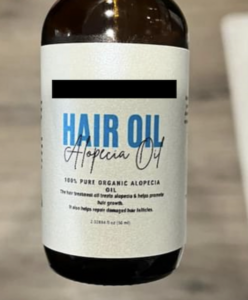
This course is making huge claims, like this hair oil cures alopecia or this lotion cures eczema or that gel assuages pain. I know you know we can’t say these things, but the people following this “course” don’t know that and they are cruising for a huge smackdown from their local cosmetics regulator, like Health Canada or the FDA, for making drug claims about cosmetics. This is all very very illegal.
Even if this hair oil did cure alopecia, you need to prove it with clinical trials and tests and all kinds of things you need to market a new drug. You can’t just watch an Instagram video that says the product will do that and make a claim. There are requirements for giving people hope for conditions that trouble them as this make them drugs. We don’t make drugs in our kitchens or workshops, and we certainly don’t sell them without evidence supporting their use.
As a question, do you want a post or two on cosmetic claims? I took a great course last year and would love to share what I’ve learned.
Related posts:
Substantiating claims: How much improvement can be expected from actives?
Do not use any of these recipes to make intimate care products at home!
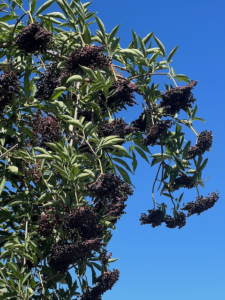
Don’t make a “yoni” oil by steeping herbs in a window in a vat of oil in the sun on a windowsill for 4 to 6 weeks. Just don’t. I can’t begin to tell you how bad an idea this is, but you can start to get an understanding by reading this post –Can I make my own glyceride, extract, infusion, or infused oil? The short answer is no no no. The longer answer contains more “no”.
Can you use an infused oil on your genitals? As my teachers used to say, you can, but should you? No, dear God, just don’t. Just don’t make things you put on your genitals and other sensitive spaces in your workshop or use something someone else has made in their kitchen or workshop.
As well, these fall under specialty products that have specific requirements and you can’t make these without testing as you can easily hurt someone. Do you want that on your conscience? If that idea doesn’t bother you, then I guess you could steep some herbs in oil and sell them for application on your genitals, but I would definitely question your ethics.
An aside on creating your own business…
I don’t want what I’m writing here to put you off starting your own business. You can create something awesome and make it your life’s work! I’ve seen so many people do it, but they’re people who really know their craft and make awesome things that have their customers returning time and again. This isn’t a business where you’ll get rich quick. You need time to get your name out there and to have people try your product and fall in love with it.
I guess you could start a business with these products, but you aren’t going to charge near the prices this guy claims you will. Definitely don’t undercut yourself or sell your products at a loss, but don’t think you’re going to charge what Lancome charges for facial moisturizers and make $15,000 from one batch of muscle gel.
Please be reasonable in your expectations: Ignore all this “get rich quick” stuff from guys like this. Learn your craft well, and make awesome, unique products that people really want.
Where to find easy-to-make formulas on this site?
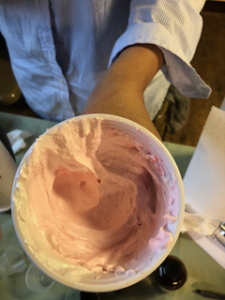
What can you do if you want to make some simple, non-giant batches of products for fun or profit or both?
I’m using this post as a jumping off point to share some of my favourite simple-to-make formulas that contain few ingredients that you can definitely make at home in your kitchen, workshop, work bench, or wherever you might want to make awesome things. You’ll need some basic things, like a scale that weighs to 1 gram, a hand mixer and/or an immersion blender, and a thermometer that you’ll definitely be using to measure temperature, but you won’t have to buy anything fancy you can’t use for other purposes. We can use bases, like foaming bath whip/foaming bath butter, or we can make our own, like a base lotion.
If you’re impatient or want to start right now, check out the beginners start here section – look up to the menu under the “resources” tab – for dozens of formulas you can make as a beginner that I promise will work if you follow the formula and process as written.
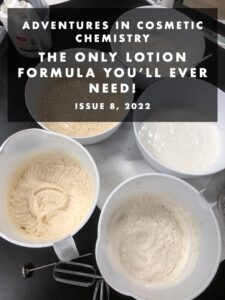
Or check out loads of my e-books with all kinds of formulas, like these ones made especially for beginners! Find these in the shop or by clicking the links! I have 80+ e-books now! (And you get a new one every month as a $10 subscriber!)
Here are a few I recommend…
The only lotion formula you’ll ever need!
Back to basics: Anhydrous products
Whipped body butters – Combining emollients for awesome products
Join me in a few days as I start sharing those formulas!
What are your thoughts on this post? What are your thoughts on any of these topics? Do you have any business things to share? Any ideas or requests for products we could make in this series or on the site? Share all of that and more in the comments!

